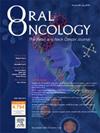舌涎癌晚期的治疗策略:一项多中心 REFCOR 研究。
IF 4
2区 医学
Q1 DENTISTRY, ORAL SURGERY & MEDICINE
引用次数: 0
摘要
简介舌涎腺癌是一种治疗难题,因为根治性切除特别伤身体。我们旨在研究晚期舌涎腺癌的肿瘤学和功能性结果:这项回顾性多中心研究以法国国家罕见头颈部癌症网络(REFCOR)为基础,纳入了2009年1月至2018年12月期间确诊的所有T3-T4舌涎腺癌患者:共纳入47名患者,其中44.7%接受了手术治疗。组织学类型主要为腺样囊性癌(61.7%),其次为其他腺癌(27.7%)和黏液表皮样癌(10.6%)。中位随访时间为 63.9 个月。在多变量分析中,手术与较好的无复发生存期(HR = 0.23,95 %CI [0.09;0.55])和局部/区域无复发生存期(HR = 0.31,95 %CI [0.10;0.95])显著相关。随访结束时,手术组的远处转移率为61.9%,非手术组为57.7%。无远处转移生存率为 54.9% [38.3;68.7],两组间无统计学差异。最终胃造瘘的比例相似,但手术组在最后一次随访时正常口服饮食的比例似乎更高(38.1% vs 15.4%):结论:该人群接受根治性手术的主要目的是改善局部/区域控制,从而改善长期吞咽功能。这些肿瘤中约有一半在初次发病时可能伴有隐匿性远处转移。有必要开展更多研究,以确定术后 RT 和同时进行 CRT 的非手术治疗的作用。本文章由计算机程序翻译,如有差异,请以英文原文为准。
Therapeutic strategy for advanced stages salivary carcinomas of the tongue: A multicenter REFCOR study
Introduction
Salivary carcinomas of the tongue represent a therapeutic challenge as their radical excision is particularly mutilating. We aimed to study the oncologic and functional outcomes of advanced stages salivary carcinomas of the tongue.
Materials and methods
This retrospective multicentric study, based on the French national network on rare head and neck cancers (REFCOR), included all patients with a T3-T4 salivary carcinoma of the tongue, diagnosed between January 2009 and December 2018.
Results
In total, 47 patients were included, of which 44.7 % underwent surgery. Histologies were mostly adenoid cystic carcinomas (61.7 %), followed by other adenocarcinomas (27.7 %) and mucoepidermoid carcinomas (10.6 %). Median follow-up duration was 63.9 months. In multivariable analysis, surgery was significantly associated with better Recurrence-Free Survival (HR = 0.23, 95 %CI [0.09;0.55]) and Local/Regional Recurrence-Free Survival (HR = 0.31, 95 %CI [0.10;0.95]). The rate of distant metastasis at the end of follow-up was 61.9 % in the surgical group and 57.7 % in the non-surgical group. The Distant Metastasis Free Survival was 54.9 % [38.3;68.7], without statistical difference between both groups. There were similar rates of definitive gastrostomies but the rate of normal oral diet at the last follow-up seemed higher in the surgery group (38.1 % vs 15.4 %).
Conclusion
Radical surgery in that population mainly aims to improve local/regional control, which may result in better long-term swallowing functions. About half of these tumors may be associated with occult distant metastasis at initial presentation. More studies are warranted to establish the role of postoperative RT and non-surgical treatment with concurrent CRT.
求助全文
通过发布文献求助,成功后即可免费获取论文全文。
去求助
来源期刊

Oral oncology
医学-牙科与口腔外科
CiteScore
8.70
自引率
10.40%
发文量
505
审稿时长
20 days
期刊介绍:
Oral Oncology is an international interdisciplinary journal which publishes high quality original research, clinical trials and review articles, editorials, and commentaries relating to the etiopathogenesis, epidemiology, prevention, clinical features, diagnosis, treatment and management of patients with neoplasms in the head and neck.
Oral Oncology is of interest to head and neck surgeons, radiation and medical oncologists, maxillo-facial surgeons, oto-rhino-laryngologists, plastic surgeons, pathologists, scientists, oral medical specialists, special care dentists, dental care professionals, general dental practitioners, public health physicians, palliative care physicians, nurses, radiologists, radiographers, dieticians, occupational therapists, speech and language therapists, nutritionists, clinical and health psychologists and counselors, professionals in end of life care, as well as others interested in these fields.
 求助内容:
求助内容: 应助结果提醒方式:
应助结果提醒方式:


